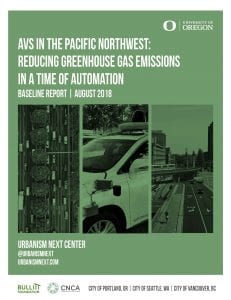 Urbanism Next is pleased to share a new report: AVs in the Pacific Northwest: Reducing Greenhouse Gas Emissions in a Time of Automation (Larco, Howell, Lewis, and Steckler). The policy decisions made over the next 10 years that shape the deployment of autonomous vehicles (AVs) will have significant repercussions for our communities as well as environmental repercussions related to greenhouse gas emissions and adaptation to climate change. In recognition of that, Urbanism Next worked with the cities of Portland, Seattle, and Vancouver, BC to better understand how new mobility technologies such as AVs could affect greenhouse gas emissions thereby impacting their ability to achieve the goals in their respective climate action plans.
Urbanism Next is pleased to share a new report: AVs in the Pacific Northwest: Reducing Greenhouse Gas Emissions in a Time of Automation (Larco, Howell, Lewis, and Steckler). The policy decisions made over the next 10 years that shape the deployment of autonomous vehicles (AVs) will have significant repercussions for our communities as well as environmental repercussions related to greenhouse gas emissions and adaptation to climate change. In recognition of that, Urbanism Next worked with the cities of Portland, Seattle, and Vancouver, BC to better understand how new mobility technologies such as AVs could affect greenhouse gas emissions thereby impacting their ability to achieve the goals in their respective climate action plans.
After conducting a literature review, reviewing existing new mobility documents, conversations with stakeholders, and conversations with partners in the public, private, and academic sectors, we compiled a variety of possible implementation actions that we think cities could consider to reduce GHG emissions. We invite you flip through and see what you think. (Please note, while we we think the actions we identified can serve as a starting point for thinking about the impacts of AVs on climate goals and how best to mitigate the potentially negative ones, we know that this will be an ongoing, iterative process as promising practices are developed.) There may be challenges ahead, there are also many opportunities to make positive changes. We hope those opportunities will seized!
This project grew out of a partnership between the Carbon Neutral Cities Alliance at the Urban Sustainability Directors Network (CNCA/USDN) and the Cities of Portland, Seattle, and Vancouver and was generously supported by the Bullitt Foundation.


Having recently delved into the electric bike and comparing the kilocaloric relationship to every form of transportation, including walking… it feels imperative that we exalt the benefits, both health and infrastructure, of cycling in urbanism. With the ebike, my realm of likelihood and possibilities have greatly expanded. AVs denote the purchase of largely higher carbon footprint vehicles, with all new embodied resources and less end-of-life realization than what is needed in a low carbon lifestyle. We have to achieve less with less, to meet the limitations of our one, blue dot.
How is it that the developers/manufacturers of a new transit technologies are not required to prove the overall value of the technology to urban habitability and accessibility in advance of its adoption? Why cannot they pay for studies exploring the merit of their “product”, rather than leaving it to cities, universities, and other agencies to pick up the tab – one way or another? Historically, transit technologies, most notably personal vehicles, have had a generally negative impact upon the habitability and sustainability of cities, including sprawl, wealth distribution and racial inequality. I say that before we adopt any policy regarding AVs that we put the onus on their promoters: prove their value in terms not only of minimizing congestion (compared to existing baselines), but also improving social equity, and conserving energy – and do it by paying for the services of objective observers from academe. There are good reasons for cities establishing the performance standards for new technologies in advance, but the industry response must be thorough and honest, not a promotional campaign.